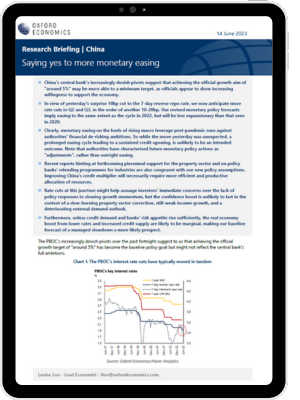China: Saying yes to more monetary easing

China’s central bank’s increasingly dovish pivots suggest that achieving the official growth aim of “around 5%” may be more akin to a minimum target, as officials appear to show increasing willingness to support the economy.
In view of the surprise PBOC cut to the 7-day reverse repo rate, we now anticipate more rate cuts in Q2 and Q3. This will bring total monetary easing to the same extent as the cycle in 2022, but less expansionary than that seen in 2020. A prolonged easing cycle leading to a sustained credit upswing is unlikely to be PBOC’s intended outcome.
What you will learn:
- Recent reports hinting at forthcoming piecemeal support for the property sector and on policy banks’ relending programmes for industries are also congruent with our new policy assumptions. Improving China’s credit multiplier will necessarily require more efficient and productive allocation of resources.
- Rate cuts at this juncture might help assuage investors’ immediate concerns over the lack of policy responses to slowing growth momentum, but the confidence boost is unlikely to last in the context of a slow-burning property sector correction, still-weak income growth, and a deteriorating external demand outlook.
- Furthermore, unless credit demand and banks’ risk appetite rise sufficiently, the real economy boost from lower rates and increased credit supply are likely to be marginal, making our baseline forecast of a managed slowdown a more likely prospect.
Tags:
Related posts

Post
Understanding Australia’s Goods Trade Dynamics in 2025
2. Explore Australia's goods trade dynamics, with rising exports and falling imports. Learn how global demand impacts the trade balance and future projections.
Find Out More
Post
Roadblocks to China’s chip self-sufficiency dream
China is unlikely to achieve full chip self-sufficiency any time soon because of high technological hurdles in producing advanced manufacturing equipment and materials. The self-sufficiency target now stretches well beyond actual fabrication to include the entire chip supply chain as China struggles to acquire necessary input and machinery into the production process.
Find Out More
Post
Five lessons for businesses navigating tariffs and trade turmoil
In a rapidly evolving global trade environment, businesses must stay ahead of changing tariffs and regulatory demands. Our latest blog offers practical guidance on navigating tariffs, understanding key trade strategies, and leveraging accurate HS code classifications to optimize your supply chain. Explore essential insights that will help your business manage trade uncertainty, ensure compliance, and unlock new growth opportunities.
Find Out More